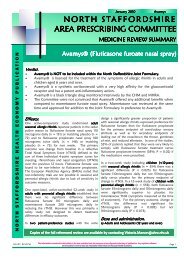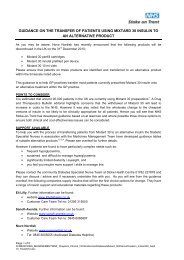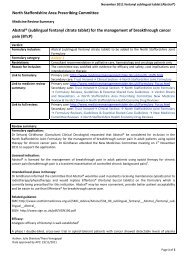(PecFent) (NMC).pdf - Medicines Management
(PecFent) (NMC).pdf - Medicines Management
(PecFent) (NMC).pdf - Medicines Management
- No tags were found...
Create successful ePaper yourself
Turn your PDF publications into a flip-book with our unique Google optimized e-Paper software.
this dose is not successful, the patient may be instructed to increase to two 400 mcg sprays(one in each nostril).Maintenance therapyOnce an effective dose has been established during titration, patients should continue to takethis dose up to a maximum of 4 doses per day.Method of administration<strong>PecFent</strong>® is for administration via the nasal route only.<strong>PecFent</strong>® can deliver 100, 200, 400 and 800 mcg doses as follows:Dose required (mcg) Product strength (mcg) Amount100 100 One spray into one nostril200 100 One spray into each nostril400 400 One spray into one nostril800 400 One spray into each nostrilThe bottle should be removed from the child resistant container immediately prior to use andthe protective cap removed. The bottle must be primed before first use by holding upright andsimply pressing and releasing the finger grips either side of the nozzle until a green bar appearsin the counting window (should occur after four sprays).If the product has not been used for more than 5 days or if it is more than 14 days since theproduct was first used, the <strong>PecFent</strong>® bottle should be discarded.To administer <strong>PecFent</strong>® the nozzle is placed a short distance (about 1 cm) into the nostril andpointed slightly towards the bridge of the nose. A spray is then administered by pressing andreleasing the finger grips either side of the nozzle. An audible click will be heard and the numberdisplayed on the counter will advance by one.Patients must be advised that they may not feel the spray being administered, and that theyshould therefore rely on the audible click and the number on the counter advancing to confirmthat a spray has been delivered.The <strong>PecFent</strong>® spray droplets form a gel in the nose. Patients should be advised not to blow theirnose immediately after <strong>PecFent</strong>® administration.The protective cap should be replaced after each use and the bottle returned to the childresistant container for safe storage.Presentation: 1<strong>PecFent</strong>® nasal spray is a clear to practically clear colourless aqueous solution. It is delivered in achild-proof container.There are two strengths available:<strong>PecFent</strong>® 100 micrograms/spray nasal spray solution5
<strong>PecFent</strong>® 400 micrograms/spray nasal spray solutionEach bottle contains 1.55 ml (1.55 mg or 6.20 mg fentanyl) ensuring delivery of 8 sprays of 100or 400 micrograms, respectively.Guidance:NICE Guidance:NICE guidance publishedYesNICE CG 140 14 ‘Opioids in palliative care’ recommends oral immediate-release morphine forfirst-line treatment for breakthrough pain in patients who can take oral opioids and suggestsseeking specialist advice if the pain remains inadequately controlled despite optimisingtreatment.The Guideline Development Group was satisfied that there was limited evidence to suggest thatfentanyl is more clinically effective than immediate-release morphine (and immediate-releaseoxycodone) for the management of breakthrough pain. However, it felt the cost impact ofrecommending fentanyl over immediate-release morphine or oxycodone in the first-linetreatment of breakthrough pain would be considerable and therefore could not be justified. 15Scottish <strong>Medicines</strong> Consortium (SMC):SMC recommended use within NHS Scotland: 3Yes<strong>PecFent</strong>® is accepted for restricted use within NHS Scotland to use in patients unsuitable forshort-acting oral opioids, as an alternative to other fentanyl preparations.Fentanyl pectin nasal spray offers an advantage in the time to onset of pain relief and reductionin pain intensity of breakthrough pain compared with placebo and immediate release morphinesulphate. Indirect comparison indicates broadly comparable efficacy to an oral transmucosalfentanyl formulation and an existing fentanyl nasal spray Instanyl®.Prescribers should be aware of the differing absorption and elimination characteristics of theavailable nasal fentanyl preparations; doses are not interchangeable.Scottish Intercollegiate Guidelines Network (SIGN):SIGN guideline publishedYesSIGN 106 16 ‘Control of pain in adults with cancer’ recommends patients with moderate or severebreakthrough cancer pain should receive breakthrough analgesia. When using oral transmucosal6
fentanyl citrate for breakthrough pain the effective dose should be found by upward titrationindependent of the around the clock opioid doseHowever, the guideline does not mention the use of intranasal fentanyl.MTRACMTRAC reviewedNoEfficacy:Outcome measures used to assess analgesic efficacy of intranasal fentanyl:Pain Intensity (PI): assessed via 11-point numeric scale at 5, 10, 15, 30, 45 and 60 min.Pain Relief (PR): assessed via 5-point numeric scale at 5, 10, 15, 30, 45 and 60 min.Pain Intensity Difference (PID): a measure of the difference in pain intensity from immediatelybefore treatment (at baseline) to after treatment.Patient–averaged Summed Pain Intensity Difference 30 min after dosing (SPID30) - a measure ofthe overall performance of a study drug over 30 min defined as the cumulative sum of therecorded difference between pain intensity and baseline at each time point from 5 to 30 minpost dose.Clinically meaningful pain relief: a ≥2-point reduction in PI.PharmacokineticsFisher et al. 17 in a phase I pharmacokinetic study in 18 opioid-naive, healthy volunteersmeasured fentanyl plasma concentrations up to 24 hrs after single dose administration of100 mcg fentanyl via the pectin nasal spray (FPNS) and 200 mcg of oral transmucosal fentanylcitrate (OTFC), respectively. Bioavailability of the nasal preparation compared with OTFC wassignificantly greater (132.4%). Furthermore, a more rapid and complete absorption wasdemonstrated with FPNS than OTFC.Fentanyl Pectin Nasal Spray (FPNS) versus placeboSummary: FPNS provided a rapid onset of effect within 5 min after dosing. A clinicallymeaningful pain relief was sustained from 10 min until the end of the 60-min observationperiod. FPNS was found to be safe and well tolerated.Portenoy et al. 4 and Taylor et al. 5 in a multicentre, randomised, double-blind, multiple-crossoverstudy assessed the efficacy and tolerability of FPNS for BTCP compared to placebo. 114 cancerpatients receiving regular opioid treatment at a total daily dose equivalent to ≥60 mg oralmorphine for background pain entered the open-label dose-titration phase. Patients whoidentified an effective dose of FPNS (ie, 2 episodes of BTCP successfully treated with the samedose of FPNS; successful defined as acceptable pain relief, no inacceptable adverse effects) wereeligible to continue into the double-blind phase (n=83). A total of 10 episodes of BTCP weretreated with either the effective dose of FPNS (7 episodes) or placebo (3 episodes). The primary7
efficacy endpoint was the sum of pain intensity difference (SPID) over 30 min postadministration;secondary efficacy measures included SPID at 10, 15, 45 and 60 min, painintensity scores (PI), pain intensity difference (PID) throughout the 60 min assessment periodand extent to which each treated episode was followed by clinically meaningful pain relief.Intranasal fentanyl significantly improved SPID from 10 min (p
which up to 10 BTCP episodes were treated (5 with FPNS and encapsulated placebo and 5 withIRMS and nasal spray placebo; n=84). IRMS was dosed at 1/6 th of the total daily oral morphineequivalent of the patient’s background opioid medication. PI and PR scores were recorded up to60 min after dosing. The primary endpoint patient-averaged PID at 15 min post dose (PID15)revealed a significant difference between the two formulations: 3.02 ± 0.21 for FPNS vs2.69 ± 0.18 for IRMS (p
Safety and adverse effects: 1Contraindications:Adverse effects:Overdose:Hypersensitivity to the active substance or to any of the excipients, use inopioid naive patients, severe respiratory depression or severe obstructivelung conditions.Common (1/100 to
Estimated cost:Dr Gahir estimates that between two and five patients would receive <strong>PecFent</strong>® each month.Treatment would typically be required for four to six weeks until the oral mucosa is regenerated.The price of each of the two concentrations of <strong>PecFent</strong>® is the same. The <strong>PecFent</strong>® trialprogramme found that 45% of patients required a dose comprising one spray (ie, £3.80) and55% needed two sprays per dose (ie, £7.60). Therefore, on average, 1.5 sprays are required perpatient, per episode of BTCP. This equals a cost per dose of £5.70. 2Estimated cost per patient per day: = 3-4 doses @ £5.70 per dose= £17.10 - £22.80 (ex VAT)Estimated cost per patient per week: £120 - £160 (ex VAT)Estimated cost per patient per course of 4-6 weeks: £480 - £960 (ex VAT)The estimated annual cost based on a number of 2-5 patients per month treated with anaverage of 3 doses per day @ £5.70 per dose is therefore: £12,480-31,200 (ex VAT).Costs of relevant comparatorsPreparation Dose regimen Cost per dose exVAT (BNF price 13 )Fentanyl nasal spray (<strong>PecFent</strong>®)100 and 400 mcg200 and 800 mcg£3.80£7.60Fentanyl nasal spray (Instanyl®)50, 100 and 200 mcg400 mcg£5.95£11.90Fentanyl lozenge (Actiq®) all strengths £5.84Fentanyl buccal tablet (Effentora®) all strengths £4.99Fentanyl sublingual tablet (Abstral®) all strengths £4.99Morphine sulphate (Oramorph®) 10mg/5ml 10 mg (1/6 th of 60mg) approx. £0.09Oxycodone hydrochloride (Oxynorm®) 5mg/5ml 5 mg (1/6 th of 30 mg) approx. £0.19Doses are for general comparison and do not imply therapeutic equivalence.11
References123456789101112131415161718<strong>PecFent</strong> 100 and 400 micrograms/spray nasal spray solution. Archimedes Pharma UK Ltd. Summary ofProduct Characteristics. Date of revision of the text November 2011. Accessed via www.medicines.org06/09/12.<strong>PecFent</strong>. Formulary Information Pack. Archimedes Pharma UK Ltd. November 2010.Scottish <strong>Medicines</strong> Consortium. Fentanyl 100microgram/dose and 400microgram/dose nasal spraysolution (<strong>PecFent</strong>®). SMC No. 663/10). 17 December 2010. Accessed viahttp://www.scottishmedicines.org.uk/files/advice/fentanyl_pectin_nasal_spray_<strong>PecFent</strong>_FINAL_DECEMBER_2010.doc_for_website.<strong>pdf</strong> 06/09/2012Portenoy RK, et al. A multicenter, placebo-controlled, double-blind, multiple-crossover study ofFentanyl Pectin Nasal Spray (FPNS) in the treatment of breakthrough cancer pain. Pain 2010;151(3):617-624.Taylor D, et al. Fentanyl pectin nasal spray in breakthrough cancer pain. J Support Oncol 2010;8(4):184-190.Portenoy RK, et al. Long-term safety, tolerability, and consistency of effect of fentanyl pectin nasalspray for breakthrough cancer pain in opioid-tolerant patients. J Opioid Manag 2010;6(5):319-28. AndErratum in: J Opioid Manag 2010;6(6):407.Radbruch L, et al. Long-term tolerability, efficacy and acceptability of fentanyl pectin nasal spray forbreakthrough cancer pain. Support Care Cancer 2012;20(3):565-573.Davies A, et al. Consistency of Efficacy, Patient Acceptability, and Nasal Tolerability of Fentanyl PectinNasal Spray Compared with Immediate-Release Morphine Sulfate in Breakthrough Cancer Pain. J PainSymptom Manag 2011;41(2):358-366.Fallon M, et al. Efficacy and Safety of Fentanyl Pectin Nasal Spray Compared With Immediate-ReleaseMorphine Sulphate Tablets in the Treatment of Breakthrough Cancer Pain: A Multicenter,Randomized, Controlled, Double-Blind, Double-Dummy, Multiple- Crossover Study. J Supp Oncol2011;9(6):224-231.Dickman A. Basics of managing breakthrough cancer pain. Pharm J 2009; 283:213-216.Portenoy RK. Treatment of cancer pain. Lancet 2011; 377:2236-2247.Grape S, et al. Formulations of Fentanyl for the <strong>Management</strong> of Pain. Drugs 2010;70(1):57-72.British National Formulary No 63 (March 2012). BMJ and Pharmaceutical Press: London.NICE CG 140. Opioids in palliative care: safe and effective prescribing of strong opioids for pain inpalliative care of adults. May 2012. Accessed via http://www.nice.org.uk/CG140 26/10/12.National Collaborating Centre for Cancer. Opioids in palliative care: safe and effective prescribing ofstrong opioids for pain in palliative care of adults. Full guideline. May 2012. Accessed viahttp://www.nice.org.uk/nicemedia/live/13745/59287/59287.<strong>pdf</strong> 26/10/12.SIGN. SIGN 106: Control of pain in adults with cancer (November 2008). Accessed viahttp://www.sign.ac.uk/<strong>pdf</strong>/SIGN106.<strong>pdf</strong> 06/09/12Fisher A et al. Pharmacokinetic comparisons of three nasal fentanyl formulations; pectin, chitosan andchitosan-poloxamer 188. Int J Clin Pharmacol Ther 2010; 48(2): 138-145.Transmucosal fentanyl products for cancer-related break-through (episodic) pain. From Palliative CareFormulary. Fourth edition 2011. Provided by ProStrakan.Produced by Sandra HeuschkelSpecialist Clinical PharmacistUniversity Hospital of North StaffordshireTelephone: 01782 674541E-mail: sandra.heuschkel@uhns.nhs.ukProduced for use within the NHS. Not to be reproduced for commercial purposes.12
















